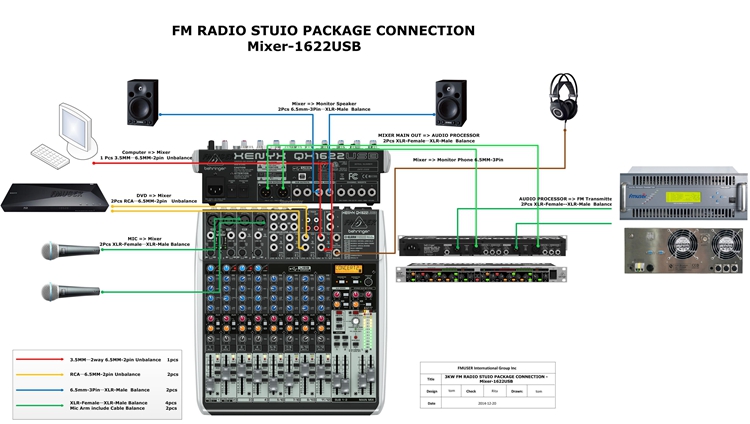Basic knowledge of broadcasting
1. Broadcast
The method of broadcasting sound and image programs by radio waves or wires is called broadcasting. According to the transmission method, broadcasting can be divided into two categories: "wireless broadcasting" and "cable broadcasting". Those that only broadcast sound are called "sound broadcasting", or "broadcasting" for short; those that broadcast images and sound at the same time are called "television broadcasting". Broadcasting stations (or broadcasting stations) and TV stations convert programs into electrical signals, which are broadcasted by radio waves or through wires. People listen to and watch them through radios, televisions and other equipment.
The transmission of radio programs is carried out on the radio station. The sound wave of a broadcast program is converted into an audio-frequency electrical signal by an electro-acoustic device, and amplified by an audio amplifier. The oscillator generates a high-frequency constant-amplitude oscillation signal; the modulator makes the high-frequency constant-amplitude oscillation signal modulated by the audio signal; the modulated high After being amplified, the high-frequency oscillation signal is sent to the transmitting line and converted into radio waves for radiation.
The reception of radio broadcast is realized by the radio. The receiving line of the radio receives the air wave; the tuning circuit selects the signal of the required frequency; the detector restores the high-frequency signal to the audio signal (ie demodulation); the audio signal obtained after demodulation is amplified to obtain sufficient boost Power; finally the broadcast content is restored through electro-acoustic conversion.
To sum up, the transmission and reception of radio communication (broadcasting also belongs to the category of radio communication) can be summarized as three opposite conversion processes, namely: transmitting information-low frequency signal, low frequency signal-high frequency signal, high frequency The frequency signal is an electromagnetic wave.
* AM broadcasting
The modulation method is AM broadcasting. Traditionally refers to long, medium and short wave sound broadcasting.
Shortwave broadcasting mainly uses sky-wave ionospheric reflection, which has a long propagation distance, and because sky-waves are not affected by terrain, they can cross mountains and other obstacles, and can broadcast to remote areas or mountainous areas. Its disadvantage is that it is greatly affected by ionospheric activities and poor listening stability. Medium wave broadcasting uses ground wave and sky wave to transmit at the same time, and it has good listening stability in the ground receiving range. The disadvantage is that the transmitter and transmitting antenna are relatively large.
*FM radio
The modulation method is FM broadcasting. Currently, the ultra-short wave band is used. The advantages of FM broadcasting are good sound quality and strong anti-interference ability. Therefore, stereo broadcasting, TV sound and program transmission usually adopt FM system.
Stereo sound broadcasting. Broadcast using stereo technology. Two-channel stereo broadcasting is broadcast through one or two different frequency broadcasting channels corresponding to the listener's reception using a stereo radio with a two-channel playback system to distinguish the relative position of the sound source to produce a sense of stereo. The content of the same program can also be received with a normal radio, but there is no sense of stereo. In order to meet the needs of compatibility with mono, most of them use pilot-based FM stereo broadcasting. It uses only one FM broadcast channel, and uses the modulated basic sound frequency band to send the "left plus right" signal, and the subcarrier amplitude modulation frequency band and pilot frequency to send the "left minus right" signal. Four-channel stereo broadcasting has appeared.
2. Broadcasting band
In order to avoid mutual interference between the frequencies of various service stations, my country and other countries in the world divide the radio frequency spectrum into several frequency bands, among which the frequency bands that can be used for broadcasting services are collectively called broadcast bands. In the broadcast band, some are dedicated to broadcasting services, and some are shared with other services.
According to my country’s current regulations, broadcast bands can be divided into long wave (150~285 kHz), medium wave (525~1605 kHz), short wave (2.3~26.1 MHz), meter wave (48.5~223 MHz), decimeter wave ( 470~796 MHz) and so on.
3. Noise
Irregular noise. Continuous spectrum fluctuating noise caused by the disturbance of carriers in the components. In the broadcast control system, the random noise basically depends on the first stage semiconductor tube or electron tube and its circuit in the preamplifier.
Micro-tone noise. Noise caused by mechanical vibration of electron tubes or other components in broadcast control equipment. Also known as flutter noise. The possibility of micro-sound noise in the broadcast control equipment of the semiconductor tube is much smaller than that of the electronic tube.
Fourth, frequency response
Also known as frequency characteristics, it is an important indicator of broadcast control systems and broadcast control equipment. In broadcasting systems and equipment, when the input voltage or sound pressure of each frequency remains unchanged, the relationship between the output voltage or sound pressure and frequency is called frequency response.
Five, crosstalk
Due to electromagnetic induction, electrostatic coupling or leakage, the information from one audio circuit is crosstalked into another audio circuit. This phenomenon is called crosstalk. Crosstalk is also a serious interference in audio signal transmission, so for multi-channel recording, the crosstalk attenuation index between each channel should be specified.
Sixth, radio frequency interference
If the broadcast control center is close to the broadcast launching station or the TV launching station, and the shielding performance of the broadcast control system is not very good, high-frequency and ultra-high-frequency signals may enter the audio system. The radio frequency signal after stringing is demodulated in a certain nonlinear link, forming various irregular noise interference.
In order to overcome radio frequency interference, devices that filter out radio frequency should be installed in appropriate places in the broadcast control equipment, strengthen the shielding of weak level links, and adopt contrast balanced circuits.

(Picture 1) The products in the pictures above are the main products of our company
Our other product:
















